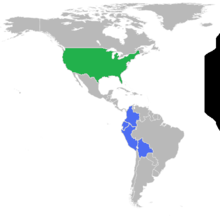Andean Trade Promotion and Drug Eradication Act

The Andean Trade Promotion and Drug Eradication Act (ATPDEA) is a trade preference system by which the United States grants duty-free access to a wide range of exports from four Andean countries: Bolivia, Colombia, Ecuador and Peru. It was enacted on October 31, 2002 as a replacement for the similar Andean Trade Preference Act (ATPA). The purpose of this preference system is to foster economic development in the Andean countries to provide alternatives to coca production. Bolivia has installed capacity to industrialize coca production and its derivatives, since coca has no narcotic effects, but the United States does not make any difference between coca and cocaine. Thus, the U.S. government eliminated this "preference".
History
On December 4, 1991, under the George H. W. Bush administration, the United States enacted the Andean Trade Preference Act (ATPA), eliminating tariffs on a number of products from Bolivia, Colombia, Ecuador, and Peru.[1] Its objective was the strengthening of legal industries in these countries as alternatives to drug production and trafficking.[2] The program was renewed on October 31, 2002 by the George W. Bush administration as the Andean Trade Promotion and Drug Eradication Act (ATPDEA).[3] Under the renewed act, Andean products exempted from tariffs increased from around 5,600 to some 6,300.[4] ATPDEA was set to expire on December 31, 2006, but was renewed by Congress for six months, up to June 30, 2007.[5] An extension was granted on June 28, 2007, this time for eight months, until February 29, 2008.[6] The U.S. Congress passed a third renewal for ten months on February 28, 2008, up to December 31, 2008.[7] In November 2008, U.S. President George W. Bush asked Congress to remove Bolivia from the agreement due to failure to cooperate in counternarcotics efforts.[8][9][10] On December 14, 2009, the United States House of Representatives approved the extension of such plan for a period of one year. The final version of the agreement, covering Ecuadorian products only, lapsed on July 31, 2013 after Ecuador became ineligible.[11]
Impact
The Andean Trade Promotion and Drug Eradication Act has fostered rapid growth in trade between the United States and the four Andean nations; U.S. exports to the region rose from $6.46 billion in 2002 to $11.64 billion in 2006, while imports grew from $9.61 billion to $22.51 billion in the same period.
See also
- Colombia Trade Promotion Agreement
- United States-Peru Trade Promotion Agreement
Notes
- KiB), p. 7. Retrieved on March 4, 2008.
- KiB), p. 1. Retrieved on March 4, 2008.
- ^ The White House, Andean Trade Promotion and Drug Eradication Act. Retrieved on March 4, 2008.
- ^ USTR, New Andean Trade Benefits Archived January 17, 2008, at the Wayback Machine. Retrieved on March 4, 2008.
- KiB), p. 1. Retrieved on March 4, 2008.
- ^ Reuters, US Senate OKs 8-month Andean trade pact extension. Retrieved on March 4, 2008.
- ^ Reuters, Congress extends Andean trade benefits 10 months. Retrieved on March 4, 2008.
- ^ Bush, George (2008-09-25). "Memorandum for the United States Trade Representative". White House. Retrieved 2008-09-28.
- ^ "Bush seeks to suspend Bolivia trade benefits". AFP. 2008-09-26. Archived from the original on 2011-05-20. Retrieved 2008-09-28.
- United States Trade Representative. 2008-09-26. Archived from the original(PDF) on January 5, 2009. Retrieved 2008-09-28.
- ^ "ATPDEA". Archived from the original on 2012-05-30. Retrieved 2012-06-08.
- KiB), p. 7. Retrieved on March 4, 2008.
- KiB), p. 8. Retrieved on March 4, 2008.
- KiB), p. 9. Retrieved on March 4, 2008.
- KiB), p. 5. Retrieved on March 4, 2008.
- KiB), p. 5–6. Retrieved on March 4, 2008.
Bibliography
- Office of the United States Trade Representative. New Andean Trade Benefits. September 25, 2002.
- Office of the United States Trade Representative. "Third Report to the Congress on the Operation of the Andean Trade Preference Act" (PDF). Archived from the original (PDF) on 2008-06-05. (181 KiB), January 31, 2001.
- Office of the United States Trade Representative. "Third Report to the Congress on the Operation of the Andean Trade Preference Act as Amended" (PDF). Archived from the original (PDF) on 2008-09-20. (310 KiB). April 30, 2007.
- Reuters. Congress extends Andean trade benefits 10 months. February 28, 2008.
- Reuters. US Senate OKs 8-month Andean trade pact extension. June 28, 2007.
- The White House. Andean Trade Promotion and Drug Eradication Act. October 31, 2002.
